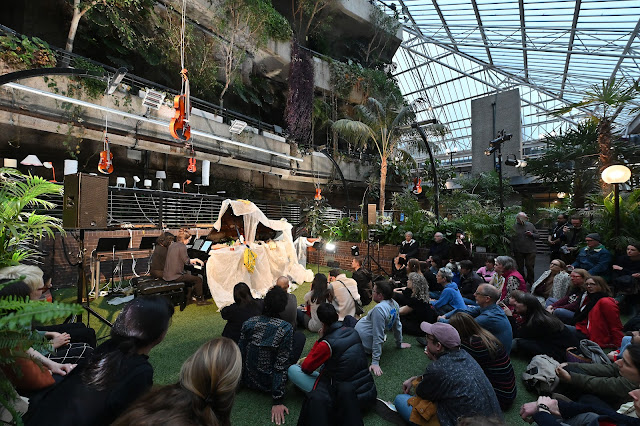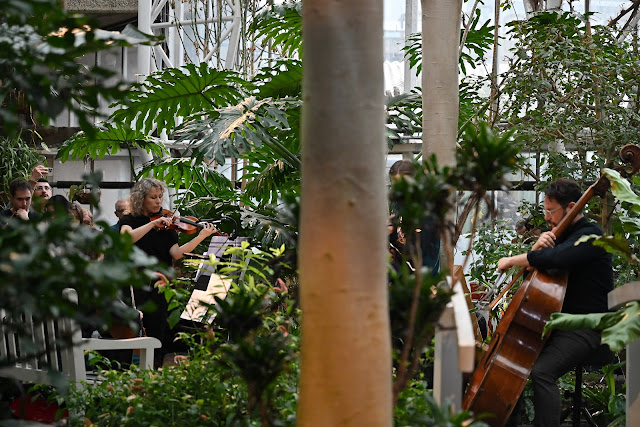 |
| The Greenhouse Effect - Nonclassical at the Barbican Conservatory (Photo: Mark Allan / Barbican) |
The Greenhouse Effect: Gabriel Prokofiev: Tracing Contours, Lines & Planes; Marcus Vergette: Tintinnabulation; Quinta Meltemia; Dasos & Chloris; Andy Akiho: Pillar: No 4; Claudia Molitor: Polymer Hauntings; Steve Reich: Music for pieces of wood; Carola Bauckholt: Doppelbelichtung; David Lang: So Called Laws of Nature ; Nonclassical at the Barbican Conservatory
Reviewed by Florence Anna Maunders; 12 March 2023
Gripping & immersive soundscapes & percussive grooves in a typically unconventional setting
Since their founding in 2004 by composer and producer Gabriel Prokofiev, London-based Nonclassical has established a reputation for presenting unusual and exciting musical events, and this was no exception. Fantastically well-attended, both the afternoon and evening shows were sold out, a clear indicator not only of the strength of Nonclassical's loyal followers, but also the currently growing appetite for unconventional approaches to contemporary and experimental music.
Nonclassical's event on 12 March 2023 took place in the Barbican Conservatory and featured music by Gabriel Prokofiev, Marcus Vergette, Quinta Meltemia, Andy Akiho, Claudia Molitor, Steve Reich, Carola Bauckholt, and David Lang, performed by percussion ensemble Abstruckt, the London Triangle Orchestra and friends.
In the incredible setting of the Barbican Conservatory – a massive indoor jungle, with layers of brutalist concrete walkways intersecting a spectacular explosion of creepers, vines, palms, banana plants and tropical foliage of all kinds – the various musicians and their instruments were laid out in different locations, as if scattered throughout the rainforest in different clearings. During the performances, it was quite possible to stroll through the pathways and bridges, but the majority of the audience chose to stand or sit nearby the performers, so as to give the music their full attention. To direct these listeners along the paths to each performance, the performers of the London Triangle Orchestra acted as guides, forming an almost-ritualistic procession of people through the jungle from site to site. Made from reclaimed steel ReBar rods, twisted into triangular form, their instruments produced a wide range of timbres, from shimmering bell-like tones, to metallic scraping and grating, composer & organiser Gabriel Prokofiev among the performers of his own piece, Tracing Contours, Lines & Planes for ReBar Triangle. This piece was directly inspired by the architecture and materials of the Barbican Centre itself – something which vividly came across when it was performed in that space.
 |
| The Greenhouse Effect - Nonclassical at the Barbican Conservatory (Photo: Mark Allan / Barbican) |
These triangle-led musical processions were the closest thing to an interval in this event – which otherwise proceeded without a pause, starting with the awesome resonances of the huge bells of Vergette's Tintinnabulation. The composer himself hand-made these instruments, each of which probably weighs in excess of a tonne, and each of which produced an immense range of timbres, rainbows of resonances, and, particularly in this performance, with the way in which the audience was able to move between and around the bells, a tangible physical (and close to, almost painful) sensation. Together with piano and double bass, the whole conservatory literally rang with the densely stacked overtones, building to climaxes in waves, and resolving into a scattering of birdcalls (provided through interaction from the audience, who had been issued clay flutes for this express purpose)
Percussion ensemble Abstrukt appeared again later in the event, from two other locations in the urban jungle to brilliantly perform the driving rhythms of two pieces which are becoming core repertoire for the percussion quartet: Reich's Music for Pieces of Wood and Akiho's Pillar No 4. With a strong sense of groove and an intimate, close-up interaction with the audience, these were both delivered with vigour, accuracy and enormously sustained energy, which Abstrukt never allowed to slack off – instead building to mesmerising polyrhythmic climaxes. By way of contrast, to conclude the show, the quartet reappeared in another clearing to give an inwardly looking, focused, and delicately poised rendition of Lang's So Called Laws of Nature, using sets of tuned chinaware – mugs and large casserole dishes to send muted resonances throbbing softly through the foliage as the sun set outside the conservatory windows.
Before that gentle finale though, was a sequence of moving and beautiful soundscapes from different performers and composers. Bauckholt's Doppelbelichtung (double exposure) filled the air with live violin sounds which interacted and duetted with electronic birdsong which emanated from speakers hidden inside suspended violins. Violinist Linda Jankowska's intensity and focus during this sustained piece was absolutely gripping, and she held the audience spellbound throughout the duration of the piece. From another clearing on the other side of the conservatory, an ensemble of electronically reproduced aeolian harp and live string instruments murmured, shimmered and bubbled, recalling the movement of wind, water and insects, in a trilogy of pieces by London-based multi-instrumentalist Quinta.
 |
| The Greenhouse Effect - Nonclassical at the Barbican Conservatory (Photo: Mark Allan / Barbican) |
But in an afternoon of delights and wonders, the most striking and memorable memory of this event was Claudia Molitor's Polymer Hauntings. Pianists Yshani Perinpanayagam and Katherine Tinker performed on, in and around a plastic sheeting-covered piano, stuffed almost to overflowing with disposable plastic waste. The confident minimalist textures of the piece gradually broke down, first to gestures, interspersed with silence, and then to the sounds created by the waste, scrunched, rattled and rustled through the audience by wandering members of the ensembles. It felt like a ritual, some kind of requiem perhaps, or an exorcism. The spirit of the music was somehow dispersed into the space and dissolved into silence. Choked maybe, by the waste materials in the instrument?
Nonclassical certainly lived up to their name, and their reputation for imaginative programming in unusual locations, combined with exceptional music-making by performers and composers of the highest international standards will only continue to grow, based on the evidence of this event. I can only recommend keeping an eye open for what they're doing next and to book well in advance. These kind of one-off events really are unique, even in London's diverse musical-cultural landscape.
Reviewed by Florence Anna Maunders
 |
| The Greenhouse Effect - Nonclassical at the Barbican Conservatory (Photo: Mark Allan / Barbican) |
The Greenhouse Effect
Gabriel Prokofiev: Tracing Contours, Lines & Planes for ReBar Triangle; Marcus Vergette: Tintinnabulation; Quinta Meltemia; Dasos & Chloris; Andy Akiho: Pillar: No 4; Claudia Molitor: Polymer Hauntings; Steve Reich: Music for pieces of wood (excerpt); Carola Bauckholt: Doppelbelichtung; David Lang: So Called Laws of Nature (movement 3)
Never miss out on future posts by following us
The blog is free, but I'd be delighted if you were to show your appreciation by buying me a coffee.
Elsewhere on this blog
- More than just a rarity: Tchaikovsky's first surviving opera, Oprichnik, gets a vibrant performance from Chelsea Opera Group - opera review
- Late-Romantic atmosphere & emotional turmoil: Ethel Smyth's Der Wald gets a rare outing - opera review
- Snakebite! composer Stephen Montague at 80 - interview
- Sending everyone away with a smile: Academy of Ancient Music in Purcell and Locke - concert review
- Shifting harmonies & tonal instability: Kitty Whately & Joseph Middleton are sympathetic & communicative in their programme of late-Romantic lieder on Befreit: A Soul Surrendered - record review
- Once you hear it, I guarantee you'll be seduced: Arne Nordheim's The Tempest, Suite from the Ballet in a new recording from Bergen - record review
- A journey through sound: looking up | looking out from a cellar full of noise - a trumpet, a tuba & live electronics create a bit of magic - record review
- An enjoyable romp: Rossini's 1825 coronation opera Il viaggio a Reims from English Touring Opera - opera review
- Style and youthful charm: English Touring Opera brings out the musical delights of Donizetti's murderous heroine, Lucrezia Borgia - opera review
- With Arctic she wanted to provide positivity and hope, to show what is worth preserving: Norwegian violinist Eldbjørg Hemsing on her latest project - interview
- Keenly dramatic: Puccini's Tosca at Opera North with a feisty Tosca, an unexpected Cavaradossi and a remarkable Scarpia - record review
- Home



%20and%20kids.jpg)
.webp)





.jpg)
No comments:
Post a Comment